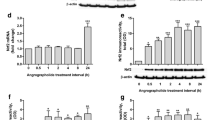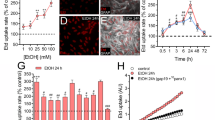Abstract
Secretion of pro-inflammatory molecules by astrocytes after alcohol treatment was shown to be associated with neuroinflammation. We hypothesized that activation of cytosolic phospholipase A2 (cPLA2) and cyclooxygenase (COX-2) by ethanol in astrocytes enhanced the secretion of inflammatory agents via the interactive tyrosine phosphorylation of toll-like receptor 4 (TLR4) and Src kinase. To test this hypothesis, we treated primary human astrocytes with 20 mM ethanol for 48 h at 37°C. Ethanol exposure elevated cytochrome P450-2E1 activity, reactive oxygen species levels, and secretion of prostaglandin E2 (PGE2) in these cells. Secretion of PGE2 was associated with induction of cPLA2 activity and protein content as well as COX-2 protein level in a Src phosphorylation-dependent manner that occurred by enhanced transcription. Immunoprecipitation and Western blot analyses indicated that the interactive tyrosine phosphorylation of TLR4–Src complex at the cell membrane triggered the activation of cPLA2 and COX-2 in the cytoplasm through a Src signaling intermediate. Inhibition of ethanol metabolism, blockage of Src activity, or inactivation of TLR4 prevented the activation of cPLA2 and COX-2 as well as diminished PGE2 production, suggesting that interactive phosphorylation of TLR4–Src regulated the pro-inflammatory response in astrocytes. Experiments with small interfering RNA knockdown of TLR4 in human astrocytes confirmed that silencing expression also abolished the interactive phosphorylation of both TLR4 and Src in the presence of ethanol.









Similar content being viewed by others
Abbreviations
- AA:
-
arachidonic acid
- AACOCF3:
-
arachidonyltriflouromethyl ketone
- ACD:
-
actinomycin D
- Ach:
-
acetaldehyde
- ADH:
-
alcohol dehydrogenase
- APC:
-
apocynin
- Chx:
-
cycloheximide
- COX-2:
-
cyclooxygenase
- cPLA2:
-
cytosolic phospholipase A2
- CYP2E1:
-
cytochrome P450-2E1
- EtOH:
-
ethanol
- 4-MP:
-
4-methylpyrazole
- NOX:
-
NADPH oxidase
- PGE2:
-
prostaglandin E2
- PP2:
-
4-amino-5-(4-chlorophenyl)-7-(t-butyl)pyrazolo[3,4-d]pyrimidine
- ROS:
-
reactive oxygen species
- Src:
-
Src kinase
- TLR4:
-
toll-like receptor 4
References
Abu-Dayyeh I, Shio MT, Sato S, Akira S, Cousineau B, Olivier M (2008) Leishmania-induced IRAK-1 inactivation is mediated by SHP-1 interacting with an evolutionarily conserved KTIM motif. PLoS Negl Trop Dis 2:e305
Aki D, Mashima R, Saeki K, Minoda Y, Yamauchi M, Yoshimura A (2005) Modulation of TLR signalling by the C-terminal Src kinase (Csk) in macrophages. Genes Cells 10:357–368
Akira S, Takeda K (2004) Toll-like receptor signalling. Nat Rev Immunol 4:499–511
Aschner M (1998) Astrocytes as mediators of immune and inflammatory responses in the CNS. Neurotoxicology 19:269–281
Blanco AM, Guerri C (2007) Ethanol intake enhances inflammatory mediators in brain: role of glial cells and TLR4/IL-1RI receptors. Front Biosci 12:2616–2630
Blanco AM, Pascual M, Valles SL, Guerri C (2004) Ethanol-induced iNOS and COX-2 expression in cultured astrocytes via NF-kappa B. NeuroReport 15:681–685
Blanco AM, Valles SL, Pascual M, Guerri C (2005) Involvement of TLR4/type I IL-1 receptor signaling in the induction of inflammatory mediators and cell death induced by ethanol in cultured astrocytes. J Immunol 175:6893–6899
Cao Z, Henzel WJ, Gao X (1996) IRAK: a kinase associated with the interleukin-1 receptor. Science 271:1128–1131
Cooper JA, King CS (1986) Dephosphorylation or antibody binding to the carboxy terminus stimulates pp 60c-src. Mol Cell Biol 6:4467–4477
Davidson D, Chow LM, Veillette A (1997) Chk, a Csk family tyrosine protein kinase, exhibits Csk-like activity in fibroblasts, but not in an antigen-specific T-cell line. J Biol Chem 272:1355–1362
Farooqui AA, Ong WY, Horrocks LA (2006) Inhibitors of brain phospholipase A2 activity: their neuropharmacological effects and therapeutic importance for the treatment of neurologic disorders. Pharmacol Rev 58:591–620
Fernandez-Lizarbe S, Pascual M, Guerri C (2009) Critical role of TLR4 response in the activation of microglia induced by ethanol. J Immunol 183:4733–4744
Gabryel B, Chalimoniuk M, Stolecka A, Langfort J (2007) Activation of cPLA2 and sPLA2 in astrocytes exposed to simulated ischemia in vitro. Cell Biol Int 31:958–965
Gardner J, Borgmann K, Deshpande MS, Dhar A, Wu L, Persidsky R, Ghorpade A (2006) Potential mechanisms for astrocyte-TIMP-1 downregulation in chronic inflammatory diseases. J Neurosci Res 83:1281–1292
Gong P, Angelini DJ, Yang S, Xia G, Cross AS, Mann D, Bannerman DD, Vogel SN, Goldblum SE (2008) TLR4 signaling is coupled to SRC family kinase activation, tyrosine phosphorylation of zonula adherens proteins, and opening of the paracellular pathway in human lung microvascular endothelia. J Biol Chem 283:13437–13449
Haorah J, Heilman D, Diekmann C, Osna N, Donohue TM Jr, Ghorpade A, Persidsky Y (2004) Alcohol and HIV decrease proteasome and immunoproteasome function in macrophages: implications for impaired immune function during disease. Cell Immunol 229:139–148
Haorah J, Heilman D, Knipe B, Chrastil J, Leibhart J, Ghorpade A, Miller DW, Persidsky Y (2005) Ethanol-induced activation of myosin light chain kinase leads to dysfunction of tight junctions and blood–brain barrier compromise. Alcohol Clin Exp Res 29:999–1009
Haorah J, Ramirez SH, Schall K, Smith D, Pandya R, Persidsky Y (2007a) Oxidative stress activates protein tyrosine kinase and matrix metalloproteinases leading to blood–brain barrier dysfunction. J Neurochem 101:566–576
Haorah J, Knipe B, Gorantla S, Zheng J, Persidsky Y (2007b) Alcohol-induced blood–brain barrier dysfunction is mediated via inositol 1, 4, 5-triphosphate receptor (IP3R)-gated intracellular calcium release. J Neurochem 100:324–336
Haorah J, Schall K, Ramirez SH, Persidsky Y (2008) Activation of protein tyrosine kinases and matrix metalloproteinases causes blood–brain barrier injury: novel mechanism for neurodegeneration associated with alcohol abuse. Glia 56:78–88
Harper C, Matsumoto I (2005) Ethanol and brain damage. Curr Opin Pharmacol 5:73–78
Harper C, Dixon G, Sheedy D, Garrick T (2003) Neuropathological alterations in alcoholic brains. Studies arising from the New South Wales Tissue Resource Centre. Prog Neuro-psychopharmacol Biol Psychiatry 27:951–961
He J, Crews FT (2008) Increased MCP-1 and microglia in various regions of the human alcoholic brain. Exp Neurol 210:349–358
Hritz I, Mandrekar P, Velayudham A, Catalano D, Dolganiuc A, Kodys K, Kurt-Jones E, Szabo G (2008) The critical role of toll-like receptor (TLR) 4 in alcoholic liver disease is independent of the common TLR adapter MyD88. Hepatology 48:1224–1231
Kapoor N, Pant AB, Dhawan A, Dwievedi UN, Gupta YK, Seth PK, Parmar D (2006) Differences in sensitivity of cultured rat brain neuronal and glial cytochrome P450 2E1 to ethanol. Life Sci 79:1514–1522
Lehnardt S, Schott E, Trimbuch T, Laubisch D, Krueger C, Wulczyn G, Nitsch R, Weber JR (2008) A vicious cycle involving release of heat shock protein 60 from injured cells and activation of toll-like receptor 4 mediates neurodegeneration in the CNS. J Neurosci 28:2320–2331
Lin CC, Lee IT, Yang YL, Lee CW, Kou YR, Yang CM (2010) Induction of COX-2/PGE(2)/IL-6 is crucial for cigarette smoke extract-induced airway inflammation: role of TLR4-dependent NADPH oxidase activation. Free Radic Biol Med 48(2):240–254
Lorne EZJ, Abraham E (2008) Role of extracellular superoxide in neutrophil activation: interactions between xanthine oxidase and TLR4 induce proinflammatory cytokine production. Am J Physiol Cell Physiol 294:C985–C993
Luo J, Lindstrom CL, Donahue A, Miller MW (2001) Differential effects of ethanol on the expression of cyclo-oxygenase in cultured cortical astrocytes and neurons. J Neurochem 76:1354–1363
Medvedev AE, Piao W, Shoenfelt J, Rhee SH, Chen H, Basu S, Wahl LM, Fenton MJ, Vogel SN (2007) Role of TLR4 tyrosine phosphorylation in signal transduction and endotoxin tolerance. J Biol Chem 282:16042–16053
Montoliu C, Sancho-Tello M, Azorin I, Burgal M, Valles S, Renau-Piqueras J, Guerri C (1995) Ethanol increases cytochrome P4502E1 and induces oxidative stress in astrocytes. J Neurochem 65:2561–2570
Norkina O, Dolganiuc A, Shapiro T, Kodys K, Mandrekar P, Szabo G (2007) Acute alcohol activates STAT3, AP-1, and Sp-1 transcription factors via the family of Src kinases to promote IL-10 production in human monocytes. J Leukoc Biol 82:752–762
Parsons OA (1998) Neurocognitive deficits in alcoholics and social drinkers: a continuum? Alcohol Clin Exp Res 22:954–961
Phulwani NK, Esen N, Syed MM, Kielian T (2008) TLR2 expression in astrocytes is induced by TNF-alpha- and NF-kappa B-dependent pathways. J Immunol 181:3841–3849
Potula R, Haorah J, Knipe B, Leibhart J, Chrastil J, Heilman D, Dou H, Reddy R, Ghorpade A, Persidsky Y (2006) Alcohol abuse enhances neuroinflammation and impairs immune responses in an animal model of human immunodeficiency virus-1 encephalitis. Am J Pathol 168:1335–1344
Qi HY, Shelhamer JH (2005) Toll-like receptor 4 signaling regulates cytosolic phospholipase A2 activation and lipid generation in lipopolysaccharide-stimulated macrophages. J Biol Chem 280:38969–38975
Qin L, Wu X, Block ML, Liu Y, Breese GR, Hong JS, Knapp DJ, Crews FT (2007) Systemic LPS causes chronic neuroinflammation and progressive neurodegeneration. Glia 55:453–462
Riikonen J, Jaatinen P, Rintala J, Porsti I, Karjala K, Hervonen A (2002) Intermittent ethanol exposure increases the number of cerebellar microglia. Alcohol Alcohol 37:421–426
Smolinska MJ, Horwood NJ, Page TH, Smallie T, Foxwell BM (2008) Chemical inhibition of Src family kinases affects major LPS-activated pathways in primary human macrophages. Mol Immunol 45:990–1000
Stevens NT, Sadovskaya I, Jabbouri S, Sattar T, O'Gara JP, Humphreys H, Greene CM (2009) Staphylococcus epidermidis polysaccharide intercellular adhesin induces IL-8 expression in human astrocytes via a mechanism involving TLR2. Cell Microbiol 11:421–432
Suryadevara R, Holter S, Borgmann K, Persidsky R, Labenz-Zink C, Persidsky Y, Gendelman HE, Wu L, Ghorpade A (2003) Regulation of tissue inhibitor of metalloproteinase-1 by astrocytes: links to HIV-1 dementia. Glia 44:47–56
Walter S, Letiembre M, Liu Y, Heine H, Penke B, Hao W, Bode B, Manietta N, Walter J, Schulz-Schuffer W, Fassbender K (2007) Role of the toll-like receptor 4 in neuroinflammation in Alzheimer's disease. Cell Physiol Biochem 20:947–956
Zheng JC, Huang Y, Tang K, Cui M, Niemann D, Lopez A, Morgello S, Chen S (2008) HIV-1-infected and/or immune-activated macrophages regulate astrocyte CXCL8 production through IL-1beta and TNF-alpha: involvement of mitogen-activated protein kinases and protein kinase R. J Neuroimmunol 200:100–110
Acknowledgments
This work was supported in part by NIH grants AA017398-01 (to YP and JH) and AA016403-01A2 (to JH).
Conflict of interest statement
The authors have no financial or other conflicts of interest.
Author information
Authors and Affiliations
Corresponding author
Rights and permissions
About this article
Cite this article
Floreani, N.A., Rump, T.J., Muneer, P.M.A. et al. Alcohol-Induced Interactive Phosphorylation of Src and Toll-like Receptor Regulates the Secretion of Inflammatory Mediators by Human Astrocytes. J Neuroimmune Pharmacol 5, 533–545 (2010). https://doi.org/10.1007/s11481-010-9213-z
Received:
Accepted:
Published:
Issue Date:
DOI: https://doi.org/10.1007/s11481-010-9213-z




